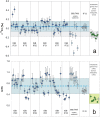Oxidative elemental cycling under the low O2 Eoarchean atmosphere
- PMID: 26864443
- PMCID: PMC4750038
- DOI: 10.1038/srep21058
Oxidative elemental cycling under the low O2 Eoarchean atmosphere
Abstract
The Great Oxidation Event signals the first large-scale oxygenation of the atmosphere roughly 2.4 Gyr ago. Geochemical signals diagnostic of oxidative weathering, however, extend as far back as 3.3-2.9 Gyr ago. 3.8-3.7 Gyr old rocks from Isua, Greenland stand as a deep time outpost, recording information on Earth's earliest surface chemistry and the low oxygen primordial biosphere. Here we find fractionated Cr isotopes, relative to the igneous silicate Earth reservoir, in metamorphosed banded iron formations (BIFs) from Isua that indicate oxidative Cr cycling 3.8-3.7 Gyr ago. Elevated U/Th ratios in these BIFs relative to the contemporary crust, also signal oxidative mobilization of U. We suggest that reactive oxygen species were present in the Eoarchean surface environment, under a very low oxygen atmosphere, inducing oxidative elemental cycling during the deposition of the Isua BIFs and possibly supporting early aerobic biology.
Figures



Similar articles
-
Fluctuations in Precambrian atmospheric oxygenation recorded by chromium isotopes.Nature. 2009 Sep 10;461(7261):250-3. doi: 10.1038/nature08266. Nature. 2009. PMID: 19741707
-
Geological constraints on detecting the earliest life on Earth: a perspective from the Early Archaean (older than 3.7 Gyr) of southwest Greenland.Philos Trans R Soc Lond B Biol Sci. 2006 Jun 29;361(1470):851-67. doi: 10.1098/rstb.2006.1836. Philos Trans R Soc Lond B Biol Sci. 2006. PMID: 16754603 Free PMC article. Review.
-
Clues from Fe isotope variations on the origin of early Archean BIFs from Greenland.Science. 2004 Dec 17;306(5704):2077-80. doi: 10.1126/science.1104639. Science. 2004. PMID: 15604404
-
Isotopic evidence for Mesoarchaean anoxia and changing atmospheric sulphur chemistry.Nature. 2007 Oct 11;449(7163):706-9. doi: 10.1038/nature06202. Nature. 2007. PMID: 17928857
-
Earth's early biosphere.Gravit Space Biol Bull. 1998 May;11(2):23-30. Gravit Space Biol Bull. 1998. PMID: 11540635 Review.
Cited by
-
Dating the evolution of oxygenic photosynthesis using La-Ce geochronology.Nature. 2025 Jun;642(8066):99-104. doi: 10.1038/s41586-025-09009-8. Epub 2025 May 28. Nature. 2025. PMID: 40437084
-
Absence of hexavalent chromium in marine carbonates: implications for chromium isotopes as paleoenvironment proxy.Natl Sci Rev. 2020 May 8;8(3):nwaa090. doi: 10.1093/nsr/nwaa090. eCollection 2021 Mar. Natl Sci Rev. 2020. PMID: 34691584 Free PMC article.
-
Early Archean origin of heterodimeric Photosystem I.Heliyon. 2018 Mar 6;4(3):e00548. doi: 10.1016/j.heliyon.2018.e00548. eCollection 2018 Mar. Heliyon. 2018. PMID: 29560463 Free PMC article.
-
Probing the Role of Cysteine Thiyl Radicals in Biology: Eminently Dangerous, Difficult to Scavenge.Antioxidants (Basel). 2022 Apr 29;11(5):885. doi: 10.3390/antiox11050885. Antioxidants (Basel). 2022. PMID: 35624747 Free PMC article. Review.
-
Early Archean origin of Photosystem II.Geobiology. 2019 Mar;17(2):127-150. doi: 10.1111/gbi.12322. Epub 2018 Nov 9. Geobiology. 2019. PMID: 30411862 Free PMC article.
References
-
- Rosing M. T. C-13-depleted carbon microparticles in >3700-Ma sea-floor sedimentary rocks from west Greenland. Science 283, 674–676 (1999). - PubMed
-
- Ohtomo Y., Kakegawa T., Ishida A., Nagase T. & Rosing M. T. Evidence for biogenic graphite in early Archaean Isua metasedimentary rocks. Nature Geoscience 7, 25–28 (2014).
-
- Nozaki Y., Zhang J. & Amakawa H. The fractionation between Yand Ho in the marine environment. Earth Planet. Sci. Lett. 148, 329–340 (1997).
-
- Bau M. & Dulski P. Distribution of yttrium and rare-earth elements in the Penge and Kuruman iron-formations, Transvaal Supergroup, South Africa. Precambrian Res. 79, 37–55 (1996).
-
- Bolhar R., Kamber B. S., Moorbath S., Fedo C. M. & Whitehouse M. J. Characterisation of early Archaean chemical sediments by trace element signatures. Earth Planet. Sci. Lett. 222, 43–60 (2004).
Publication types
LinkOut - more resources
Full Text Sources
Other Literature Sources

